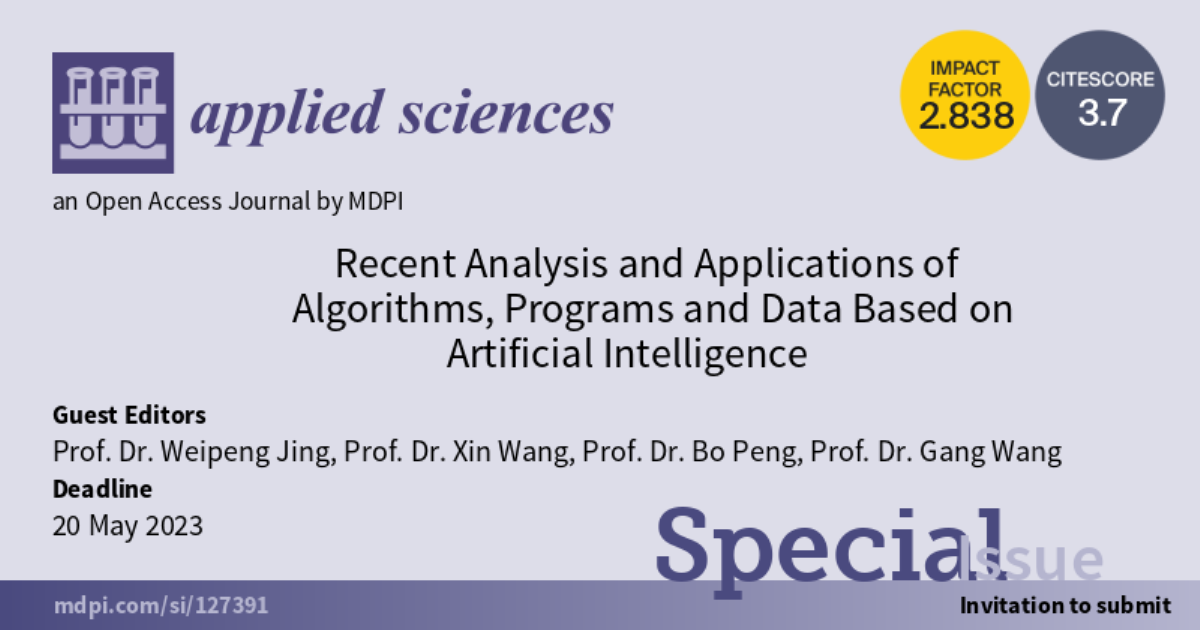Recent Analysis and Applications of Algorithms, Programs and Data Based on Artificial Intelligence
A special issue of Applied Sciences (ISSN 2076-3417). This special issue belongs to the section "Computing and Artificial Intelligence".
Deadline for manuscript submissions: closed (20 May 2023) | Viewed by 59357

Special Issue Editors
Interests: remote sensing; machine learning; artificial intelligence; cloud computing; parallel and distributed computing
Special Issues, Collections and Topics in MDPI journals
Interests: knowledge graphs; graph databases; big data; distributed processing
Special Issues, Collections and Topics in MDPI journals
Interests: medical image analysis; medical ultrasound imaging; GPU computation
Special Issue Information
Dear Colleagues,
The development of big data technology has led the world into a new era of intelligence. From daily life to industrial production, massive data and various intelligent algorithms, including machine learning and deep learning, assist in intelligent identification and decision making, bringing great convenience to human life. Cutting-edge research is rapidly developing, such as speech and image recognition, recommendation systems, smart cities, smart medical, and business intelligence. Moreover, artificial intelligence technology plays a significant role in software development and system design. Expectations for smart systems and applications are increasingly growing; it is thus crucial to analyze and optimize algorithms and data structures to improve their accuracy and efficiency.
This Special Issue aims to disseminate recent research results and advancements related to artificial intelligence and big data, with particular emphasis on their applications in algorithms, model optimization, data analysis, data processing, system development, AI systems, intelligent algorithms, integration, and other new technologies. We invite researchers and practitioners to contribute high-quality original research or review articles on these topics to this Special issue.
Prof. Dr. Weipeng Jing
Prof. Dr. Xin Wang
Prof. Dr. Bo Peng
Prof. Dr. Gang Wang
Guest Editors
Manuscript Submission Information
Manuscripts should be submitted online at www.mdpi.com by registering and logging in to this website. Once you are registered, click here to go to the submission form. Manuscripts can be submitted until the deadline. All submissions that pass pre-check are peer-reviewed. Accepted papers will be published continuously in the journal (as soon as accepted) and will be listed together on the special issue website. Research articles, review articles as well as short communications are invited. For planned papers, a title and short abstract (about 100 words) can be sent to the Editorial Office for announcement on this website.
Submitted manuscripts should not have been published previously, nor be under consideration for publication elsewhere (except conference proceedings papers). All manuscripts are thoroughly refereed through a single-blind peer-review process. A guide for authors and other relevant information for submission of manuscripts is available on the Instructions for Authors page. Applied Sciences is an international peer-reviewed open access semimonthly journal published by MDPI.
Please visit the Instructions for Authors page before submitting a manuscript. The Article Processing Charge (APC) for publication in this open access journal is 2400 CHF (Swiss Francs). Submitted papers should be well formatted and use good English. Authors may use MDPI's English editing service prior to publication or during author revisions.
Keywords
- big data processing
- intelligent data analysis
- AI for system
- computer vision
- intelligent signal processing
- smart medical
- business intelligence
- hybrid methods
- optimization algorithm
- algorithm optimization
Benefits of Publishing in a Special Issue
- Ease of navigation: Grouping papers by topic helps scholars navigate broad scope journals more efficiently.
- Greater discoverability: Special Issues support the reach and impact of scientific research. Articles in Special Issues are more discoverable and cited more frequently.
- Expansion of research network: Special Issues facilitate connections among authors, fostering scientific collaborations.
- External promotion: Articles in Special Issues are often promoted through the journal's social media, increasing their visibility.
- e-Book format: Special Issues with more than 10 articles can be published as dedicated e-books, ensuring wide and rapid dissemination.
Further information on MDPI's Special Issue polices can be found here.








